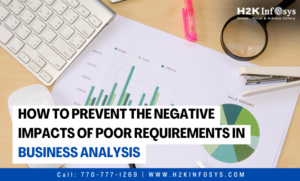A data scientist’s typical day involves gathering huge data, evaluating it, and applying statistics to explain trends. For their study, data scientists employ tools like R and Python, and a significant portion of their work involves presenting their findings visually.
Business Analyst and a Data Scientist different because the latter’s emphasis is on the business model itself. Business analysts use a more integrated approach than data scientists, who see business via a statistical lens. A good Data science online course should explain the difference between a Data scientist and a Business analyst.
Business Analyst and a Data Scientist Doctoring the Business Model
Like a doctor, a business analyst evaluates a business model as though it were a patient.
A business analyst has similar training to a doctor in their speciality. Paediatricians are experts in children’s health, and cardiologists are experts in the heart. In the same way, a business analyst for a vehicle company would be an expert on cars, and a business analyst for a fast food restaurant would be an expert on the fast food sector.
Similar to how a doctor takes a patient’s height, weight, and temperature and records that information in a patient’s medical record, a business analyst gathers data on profits, losses, and growth to generate reports.
To determine whether the business strategy aligns with the firm goals, business analysts consult with stakeholders, customers, and other business divisions. This is comparable to how a doctor interacts with nurses, office personnel, and patients to not only diagnose and treat patients but also to ensure the seamless operation of the practice.
The business analyst will have a thorough awareness of the market the company services as well as its demographics, setting, and close rivals. Analysing past data would give the analyst knowledge of the company’s performance over time. Additionally, they will spot seasonal tendencies and counsel management on them.
Consider the fast-food restaurant business as an example. A business analyst can investigate the particulars of one chain store, determining, for instance, why sales are lagging behind those of the same store in the past or those of other locations currently operating in the chain. Alternatively, it might examine certain details for the entire chain and how they stack up against those at other chains.
To do analysis, business analysts employ specialised models and tools like time series. They analyse historical data to obtain insight and forecast future business success. Consider Wall Street and US company quarterly reports. The expectations listed here are samples of the final products that business analysts create by analysing historical data, market trends, supply and demand, and so on.
The business analyst must then create a report following the completion of all data collecting, communication, and evaluation tasks. Excel should be used to create simple graphs and charts that display the data. Microsoft Word and PPT are also essential tools for a business analyst because reports must have models that are simple to grasp and be shared with staff. The report will start a discussion about the present business model and whether or not it needs to be adjusted between the business analyst and the company’s decision-makers.
A business analyst may occasionally be asked to offer software to solve needs found when analysing the business model. In this role, a business analyst must be able to interface with programmers, and adjust systems, as well as with users to train and address any questions or problems that arise.
Data Scientists and the Market Pulse
Data scientists differ from business analysts in that they are not always subject-matter experts, but they can be. Data scientists are independent of any one industry or company. Instead, they can apply their knowledge and resources to previously unrelated sectors with ease. The data scientist is more like a heart rate monitor than a business analyst or doctor since they are data experts rather than subject matter experts. Data scientists measure the market’s pulse right now.
For instance, if the aforementioned fast food company hired a data scientist, the scientist would want to record every sales event, including the day of the week, the food ordered, the time the order was placed, and customer information. Like business analysts, data scientists aren’t interested in summaries and overall revenues. Instead, to spot trends and patterns in the data, data scientists try to record exact details.
A data scientist would make an effort to include each and every data event into a mathematical model that serves as a foundation for forecasts of future events. They are familiar with the sophisticated mathematics and machine learning tools required for such prediction models. Returning to the restaurant example, a complicated statistical pipeline may show, for instance, that Wednesday nights have historically been low sales. Assuming that all other times are exactly identical in sales, a very simple maths model to match the data to would be a linear model with a valley in the middle. In other words, the maths model would be a horizontal line with a dip in the middle, similar to a sine curve, assuming that every day of the week was constant.
With such a model in mind, data scientists can come up with ideas for promotions like “happy hour” or “buy one get one free” to increase Wednesday night sales. When the promotions are applied, a data scientist may run simulations or compare the sales to those of other franchises to determine which strategy will yield the highest profit margins.
A data scientist is in charge of not just spotting these trends but also presenting the findings and options to decision-makers. Statistical programming and visualisation software are typically used, although Excel can be used.
The Tools of the Trade
Business models are important to a business analyst’s universe. They are either reporting, talking about, or changing the company model. They must be outstanding researchers and problem-solvers in addition to being Microsoft Office experts. Additionally, as business analysts work with every aspect of the company, exceptional communication skills are a requirement. They must also be “team players” with the ability to communicate and collaborate across all corporate divisions.
Business analysts’ job descriptions are very different from those of data scientists. As opposed to report writers and corporate communicators, they are mathematicians and are conversant in programming languages. As a result, they employ a separate set of tools. A data scientist needs to be proficient in using computer languages, comprehending the fundamentals of machine learning, and creating and using mathematical models.
Business analysts and data scientists have in common the need to produce and communicate reports with lots of figures. Even though the two jobs may utilise the same software to create these reports, the content of the reports will be very different.
Which is right for you?
Imagining the kind of position you want should help you decide between a future career as a business analyst or a data scientist. Are social interactions something you enjoy? Do you enjoy making reports by condensing information? If so, a business analyst role is more likely to make you happy than one as a data scientist because the latter works more independently. A career as a data scientist can be right for you if you have a more technical background because data scientists are also more technical.
Conclusion You can check out the online Data science course to learn more about Data scientists.


























